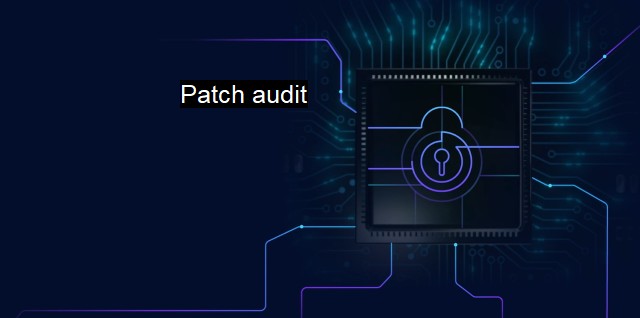What is Patch audit?
Why Patch Management Audits are Crucial for Cybersecurity: Managing Vulnerabilities and Maintaining System Integrity
Patch auditing is a critical aspect of cybersecurity that involves keeping software, systems, and infrastructure updated to prevent malicious attacks and potential intrusions. Primarily, a patch is a set of changes applied to an operating system, software, or firmware to amend system vulnerabilities, fix bugs, improve usability, or enhance functionality. simply deploying patches whenever they become available is not enough. A thorough and regular patch audit ensures that all computer systems in an organization are up-to-date, free from vulnerabilities, and running at optimal performance.What makes patch audits important is the changing nature of the cyber threat landscape. As fast as companies identify and block potential vulnerabilities, cybercriminals, micro-coders, and hackers are discovering and exploiting new ones. Patches are designed to correct these vulnerabilities and defend against these threats, acting as an essential preventative tool in the organization's cybersecurity infrastructure. If a patch is missed or misapplied, vulnerabilities can be left open to exploitation, resulting in potential breaches in security.
A patch audit is not merely limited to checking whether the necessary patches have been implemented. This process also involves monitoring the performance of the patches in production. Auditing helps identify any misconduct or irregularities, ensuring that each new bit of code operates seamlessly without causing downtime or glitches. patch audits can be instrumental in streamlining software updates and making certain that no critical updates have been missed.
Equally vital in the patch auditing process is understanding which systems require patching. This includes not only machines located in the office, such as desktop computers and servers but it also includes remote laptops, mobile phones, and even Internet of Things (IoT) devices remotely. The audit needs to be exhaustive and systematic, keeping track of every device's patch status and ensuring the comprehensive security of the whole network.
Applying patches without a proper evaluation could lead to compatibility issues. Consequently, part of a patch audit involves compatibility testing to ensure the patches play well with the pre-existing systems and applications. Also, the verification of the source is important to avoid counterfeit or malicious patches, avoiding threat mitigation instead of enhancing potential risks.
Fixing security weaknesses, the patch also enhances system utility by improving operation speed and feature enhancements. This makes a patch audit integral to maintain and improve the system's productivity in an organization. As a preventive measure against potential threats, the necessity for a patch audit is invaluable to businesses in this age of digital operations.
On the flip side, failure to properly conduct an audit may lead to the introduction of new vulnerabilities, as hackers exploit unpatched software, and even potential reliability impact. Therefore, a significant part of the patch audit process includes re-auditing, to make sure that patches have not only been applied but are working as they should be, lending peace-of-mind for CTOs who can be assured their systems are suited against threats in this continuously evolving cyber landscape.
Patch auditing is a requisite practice as part of an organization's cybersecurity strategy. It is essential to make sure that they are not just being applied randomly, but they are tailored to an organization's system and businessneeds. Focusing exclusively on threat prevention, patch audits also provide advantageous fixes and updates crucial for system performance and reliability. Patch audits offer two security tiers — fixing known vulnerabilities while proactively positioning against unknown threats, making them an invaluable inclusion in the realm of cybersecurity.

Patch audit FAQs
What is a patch audit?
A patch audit is a security process that reviews and evaluates the patches or updates installed on a system or network to ensure they are up-to-date and free from vulnerabilities. It is an essential component of cybersecurity that helps to identify any gaps, errors or risks in the software or operating systems.Why is patch audit important for cybersecurity?
Patch audit is important for cybersecurity because it helps to identify and mitigate vulnerabilities in operating systems, software, and applications. By regularly reviewing and updating patches, organizations can prevent hackers from exploiting known vulnerabilities and compromising their systems. Patch audit also helps in ensuring regulatory compliance and avoiding potential cyber attacks.What are the steps involved in the patch audit process?
The patch audit process involves several steps, including identifying the systems and software to be audited, reviewing the security bulletin to identify relevant patches, testing the patches in a controlled environment, deploying the patches, and verifying that the patches have been successfully installed. It is also important to document the entire process for future reference and analysis.How frequently should patch audits be conducted?
Patch audits should be conducted on a regular basis, ideally quarterly or bi-annually, depending on the size and complexity of the organization's IT infrastructure. Critical patches should be deployed immediately, while other patches can be tested and rolled out in batches. It is also important to keep track of newly discovered vulnerabilities and corresponding patches to ensure that systems are kept up-to-date and secure.| | A | | | B | | | C | | | D | | | E | | | F | | | G | | | H | | | I | | | J | | | K | | | L | | | M | |
| | N | | | O | | | P | | | Q | | | R | | | S | | | T | | | U | | | V | | | W | | | X | | | Y | | | Z | |
| | 1 | | | 2 | | | 3 | | | 4 | | | 7 | | | 8 | | |||||||